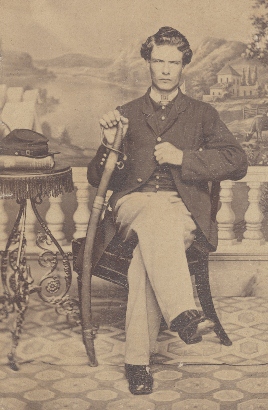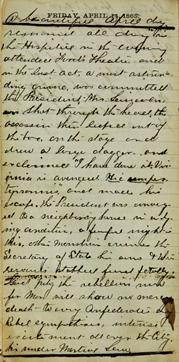Diaries digitized by UC Merced tell first-hand of Civil War, Lincoln assassination
A new digital collection provides a glimpse into the everyday life of a Union soldier during the U.S. Civil War, as well a first-hand account of President Lincoln’s assassination and its aftermath. The UC Merced Library contributed the collection to the Online Archive of California (OAC), Calisphere, and Merritt, in what appears to be the final chapter in a search for Lincoln’s last written words.
. View the collection on the OAC
A soldier’s story


Henry O. Nightingale (1844-1919) was an abolitionist from Rochester, New York who at 18 years of age enlisted in the Northern army at the start of the Civil War. Nightingale fought in numerous battles, including the Battle of Gettysburg.
Nightingale’s account of the war is brought to life in the new digital collection, which comprises two handwritten diaries (1864-1865) and an undated portrait of the soldier with his sabre and Union hat. A majority of entries in both diaries describe the weather and Nightingale’s daily activities during his military service. The 1864 diary is notable for its descriptions of company and regimental movement, as well as a gunshot wound Nightingale suffered at the Battle of the Wilderness in Virginia.
The 1865 diary describes one of the most infamous events in American history. On April 14, Nightingale attended a performance at Ford’s Theatre. There, he witnessed the assassination of President Abraham Lincoln by John Wilkes Booth. Nightingale recounted the horrific scene, writing:
…in the last act, a most astonishing crime was committed the President. Mr. Lincoln, shot through the head; the assassin then leaped out of the box on the stage and drew a large dagger and exclaimed “I have done it. Virginia is avenged. Hic [sic] semper tyrannis” and made his escape.
The outraged Union soldier went on to write, “God pity the rebellion now for Men will show no mercy; death to every Confederate, every Rebel sympathizer.”
. Read Nightingale’s account of Lincoln’s assassination (http://content.cdlib.org/ark:/13030/kt4b69r9x7/?order=115)
If you find the handwriting difficult to read, don’t distress. Student assistants at the UC Merced Library have been transcribing the diaries, and the transcriptions will be added later this spring.
A missing autograph
The digitization of the diaries was actually part of an effort to uncover Lincoln’s signature and possible last written words. A historian and genealogist named Steve Nagy, along with his brother and a cousin, had inherited letters Nightingale wrote to their ancestor—probably as a “pen pal” during the war. In 2007, while transcribing the letters, a member of the Digital Library Team at Villanova University discovered a surprising passage:
I, the afternoon of the fatal day, had the pleasure of seeing the departed one, my object in going to see him was to get his Autograph in my Album. he, the President took it and wrote with his own hand several lines.
In other words, Nightingale claimed to have an autograph and inscription from Lincoln on the day he died.
Mr. Nagy, his curiosity piqued, undertook to find Nightingale’s heirs and see if they had additional materials where the autograph might be penned. The search took him to California, and eventually to Edith Denio, a great-granddaughter of Nightingale’s who was in possession of the diaries. Ms. Denio generously allowed UC Merced staff to digitize the diaries for public access and study.
And what of the autograph? Unfortunately it did not turn up in the diaries. Either it is in another volume, or—as Mr. Nagy conjectures—Nightingale embellished the story in the letter to his pen pal, and did not actually procure a signature from President Lincoln.
The making of a digital collection
The publication of this collection is the result of countless hours and hard work at the UC Merced Library. Since the diaries are physically fragile and quite long—together they contain several hundreds of pages—they presented a challenge to library staff.
Head of Digital Assets Emily Lin and a student assistant employed gentle, labor-intensive methods to scan the thin handwritten pages, as well as the many newspaper clippings and poems pasted into one of the diaries. Student assistants painstakingly cataloged and transcribed the diaries. Library Services Manager Mary Weppler-Selear took on the digital curation of the collection as a capstone project for a certificate in digital information management. She supervised the students, created metadata, and did all of the technical work required to contribute the collection to the CDL’s access and preservation repositories.
The Nightingale collection is available on the OAC and Calisphere, and has been deposited in the Merritt digital curation repository—thus ensuring both broad public access to and long-term preservation of these historically significant materials.
Explore other first-hand stories
Handwritten letters and diaries comprise some of the most engrossing material available on the OAC and Calisphere. If you like the Nightingale diary, you may also be interested in the diary of Patrick Breen, member of the Donner Party; the letters of John Muir, and words and writings from the Japanese American Relocation Digital Archive.
